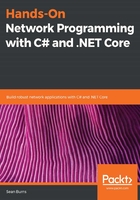
An arbitrarily large set
What do we mean when we say arbitrarily large? Well when you're writing software for a router (accepting that you would realistically be bound by the maximum size of physically-addressable space), you would not (and should not) care about how many devices are actually connected to your hardware, or how many routes you need to reliably pass resources or requests along. Suppose you are writing the system software for a wireless router. While doing so, you tell your product owner that their marketing copy should specify that this router can only connect a maximum of four computers to the internet. Can you imagine any product owner would take that news kindly? You would be looking for a new job in no time! Networks must be able to scale with the needs of their users.
A basic property of almost all computer networks is device-agnosticism, which is to say that any device on a network should assume no knowledge of the number or kind of other devices on that network at any given moment. Indeed, a program or device might need to discern whether or not a specific device or piece of software exists on the network, but nothing about the network connection it obtains will convey that information. Instead, it should be equipped to send and receive messages in a format that is typically standardized for the communication protocol over which the messages are sent. Then, using these standardized messages, a device can request information about the availability, configuration, or capabilities of other devices on the network, without actually knowing whether or not the devices it expects to be available on the network are, in fact, available on the network.
Ensuring that the receiving end of any given outgoing connection from a device is properly connected, or that the receiving devices are configured accordingly, is the concern of the network engineers who support your software. Supporting and responding to requests sent by your software is the responsibility of the authors of the receiving software. Obviously, if you're working in a sufficiently small software shop, both of those roles may well also be filled by you; but in a sufficiently mature working environment, you can likely rely on others to handle these tasks for you. However, when the time comes to deploy your software to a networked device, no information about whether or not those responsibilities were handled properly is available to you simply by virtue of being connected to a network.
Device-agnosticism means that a network has no idea what has connected to it, and, accordingly, cannot tell you as much. A corollary attribute of networks is that other devices on the network cannot and will not be notified that your device or software has connected and been made a resource.
Ultimately, this is what is meant by an arbitrarily large set of devices. Technically, a single computer constitutes a network of one node, and zero connections (though, for the purposes of this book, we'll only be considering networks with at least two nodes, and at least one connection between any given node and any other node on the network), but there is no fixed maximum value of nodes beyond which a network ceases to be a network. Any arbitrary number of nodes, from one to infinity (or whatever the maximum number of physically possible nodes may be), constitutes a valid network, so long as those nodes have some valid connection between themselves and the rest of the network.